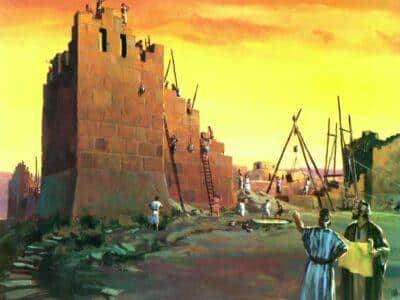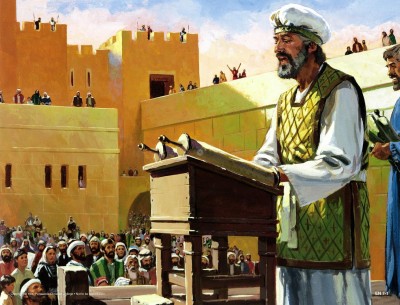The Restoration was actually a far more glorious time than ever before, in terms of spiritual power, though not in terms of outward glory and splendor.
—James Jordan, Through New Eyes (1988)
Cyrus took the prophecy of Isaiah to heart and so became God’s anointed shepherd at a key moment in redemptive history.
—Greg Uttinger, Prologue (2004)
The End of the Beginning

The Restoration Era is the most neglected and misunderstood part of redemptive history. It begins with the fall of Babylon and the decree of Cyrus. It continues on through some of the lesser-known books of Scripture… Ezra, Nehemiah, and Esther… and it extends through the 400 Silent Years and the nearly coextensive Hellenistic Age. It culminates in the Advent of Christ.
At first glance, this era seems pretty small compared to Noah’s flood, the miraculous beginnings of the Mosaic covenant, or the political glories of the Davidic kingdom. The Restoration Era lacked any signs and wonders. Prophets didn’t call fire from heaven; they didn’t turn rivers to blood or inundate the land with frogs or lice. They didn’t command the sun to stand still in the heavens or invite it to slide backwards through the sky. Godly kings didn’t lead armies to great victories, nor did the angel of death intervene when the sword failed. Mostly, God’s people lived and suffered and endured and passed on the faith to the next generation.
And yet the godly men and women of that age changed the course of history forever.
Cyrus the Great
The Babylonian Captivity lasted 70 years. Then Babylon fell to the armies of Cyrus, the new king of Persia. We know Cyrus from secular history, particularly from Herodotus’s Histories. But long before Herodotus, long before Cyrus himself was born, the prophet Isaiah called Cyrus by name. Isaiah wrote:
Thus saith the LORD, thy redeemer, and he that formed thee from the womb, I am the LORD that maketh all things . . . that saith of Cyrus, He is my shepherd, and shall perform all my pleasure: even saying to Jerusalem, Thou shalt be built; and to the temple, Thy foundation shall be laid (Isa. 44:24, 28).
Isaiah even goes on to call Cyrus the LORD’s anointed, His messiah (45:1). God had predestined all of ancient history to bring forth Cyrus… this particular Cyrus, and no other… to rule Medo-Persia, to topple Babylon, and to send Israel home. The prophecies of Isaiah were an implicit command to Cyrus to finish his predestined course.
Someone, probably Daniel, carried Isaiah’s prophecies to Cyrus and laid them out before him. He took them seriously. For in the first year of his reign, Cyrus made this proclamation:
The LORD God of heaven hath given me all the kingdoms of the earth; and he hath charged me to build him a house at Jerusalem, which is in Judah. Who is there among you of all his people? His God be with him, and let him go up to Jerusalem, which is in Judah, and build the house of the LORD God of Israel, (he is the God,) which is in Jerusalem (Ezra 1:2-3).
Both historically and prophetically, then, Cyrus was God’s instrument. Cyrus delivered Israel from bondage and ordered Jerusalem and its Temple rebuilt (Isa. 45:13). In doing so he prepared the way for God’s true Messiah.
The Return Home
Israel’s deliverance from Babylon was a new exodus. Israel had been in an iron furnace, a lion’s den, and God called her out (cf. Dan. 3, 6). She was like a valley of dead bones, and the Spirit of God resurrected her (Ezek. 37). But the full work of restoration took time.
Zerubbabel, the prince of Judah, and Jeshua the high priest led the first return to Palestine (Ezr. 1—3). Zerubbabel stood in the line of Davidic kings, but through a curse on his ancestor Jeconiah, God barred him and his natural seed from the throne (Jer. 22:24-30). So Zerubbabel, the man who could have been king, served only as a governor in the service of Cyrus and Persian bureaucracy.
Once they reached Jerusalem, Zerubbabel and Jeshua renewed God’s altar and reinstituted the blood sacrifices that God required. Then they turned to the work of rebuilding the Temple itself. Here they faced opposition from their Samaritan neighbors, who frustrated the Jews’ work by constant appeals to the Persian capital (Ezr. 4). In fact, the Samaritans managed to get a royal decree ordering a temporary halt to the rebuilding of Jerusalem. The decree, however, said nothing about the Temple.

Finally, through the ministry of the prophets Haggai and Zechariah, God’s people got back to work on the Temple. Further Samaritan appeals to Persia only brought about imperial approval and support of the whole project (Ezr. 5—6).
Ezra, Nehemiah, and Esther
In the next generation, Ezra the scribe returned to Jerusalem to instruct Israel in the law of God (Ezr. 7). But he found Israel horribly compromised. Many among the covenant people had married foreign wives. Ezra acted swiftly to recover Israel out of this snare. His teaching ministry continued into Nehemiah’s rule as governor.
About this time, a Jewish girl named Esther became queen of Persia. At the advice of her older cousin, Mordecai, she used her position and influence to rescue Israel from the genocidal schemes of a wicked courtier, a man named Haman. Haman fell from power, and Mordecai became prime minister of the Persian Empire for a time.
Shortly afterwards, Nehemiah, the king’s cupbearer, obtained permission from the king to return to Jerusalem and rebuild the city’s walls. He, too, faced opposition from Israel’s enemies. But through steadfast faith and courage, he finished his work. God’s people rebuilt the walls of Jerusalem and dedicated them to God. Jerusalem became the Holy City.
Under Nehemiah’s leadership, the people of Israel swore an oath, renewing their covenant with the LORD (Nehemiah 9—10). The Restoration Covenant was now formally written and sealed. Then Malachi prophesied closing the canon of the Old Testament, and Israel waited four hundred years for the Messiah.
The Restoration Era: The Balance Sheet
In terms of outward glory and power, the Restoration Era seems pretty subdued compared to some of God’s other great works in history. The Return was never complete. Many of God’s people were still scattered across the earth. Those who had returned to Palestine were always secondary to whatever world-empire held the center stage of history at the time. The Davidic king was gone. Israel maintained her liberties and laws only at the pleasure of a Gentile emperor. The rebuilt Temple was a poor shadow of Solomon’s. Size and adornments apart, it lacked the Ark of the Covenant, the tables of stone, the priestly Urim and Thummim, the divine fire on the altar, and the blessed Shekinah glory within the Holy of Holies. There were no more miracles, and after Malachi, no more prophets.
On the other hand…and far more important… Israel had the completed Old Testament. Israel had a clearly drawn picture of the coming Messiah, overflowing with divine wisdom and instruction. Israel had the living word of God that quickens hearts and changes lives. Israel had, in short, a spiritual power never before loosed on earth.
And in every city throughout the known world, there were synagogues that taught God’s Word (Acts 15:21). The scattered Jews were already bearing witness to their Gentile neighbors of the coming Savior and King.
In the Fullness of Time
In the last days of the Old Covenant era, God prepared His people for the next stage in His holy war against sin and death. He took away their political and military power. He withdrew His miracles. He taught His people to live in terms of the regularities of His providence and covenant. He taught them that they had to live by every word of God. He kept them scattered throughout the known world so that their close communities and lay synagogues could become staging grounds for the evangelistic outreach of the New Testament Church. And then He brought His Son into the world.
Jesus came in the closing days of the Restoration Era—in the “last days,” or as Paul says, “in the fullness of time” (Heb. 1:2; Gal. 4:4). All of ancient history was preparation for Christ’s coming. Each new era, each new empire, was another step in God’s eternal plan of redemption. Each covenant renewal was a new campaign in His holy war against the darkness. And it all came together at Calvary. God triumphed in weakness … winning through the death of His Son. Little has changed. This is the way the Kingdom comes.










